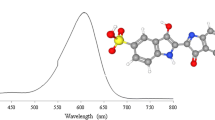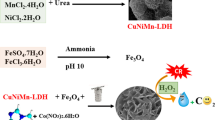Abstract
In this work, flower-like β-Ni(OH)2 nanoarchitectonic particles were successfully synthesized via a simple homogeneous precipitation method. The crystal structure and morphology were detected by x-ray diffraction (XRD) and scanning electron microscopy (SEM), respectively. The influence of the dosage of β-Ni(OH)2 and potassium persulfate (PS) on adsorption and degradation of cresol red dye was studied. The results indicate that when the dosage of β-Ni(OH)2 was larger than 5 g/L, the major reason for cresol red dye removal was adsorption due to its large specific surface area of 45 m2/g. However, when the dosage of β-Ni(OH)2 was 0.5–0.7 g/L, the adsorption effect on cresol red dye was not obvious, but the degradation effect became significant after adding 0.3–0.5 mmol/L PS, benefiting from the strong activation of PS to generate ·SO4−, ·OH− and S2O8− radicals by β-Ni(OH)2. The degradation efficiency of 0.1 mmol/L cresol red dye reached over 98% in a neutral or alkaline medium. In particular, at pH = 9, the initial degradation efficiency was 99.9% and remained 99.25% after eight cycles. Thus, the high activity and stability make β-Ni(OH)2 a promising catalyst for activating persulfate to degrade organic pollutants.






Similar content being viewed by others
References
U. Uthirakrishnan, X. Lu, J. Wang, Z. Zhang, J. Dai, Y. Tan, S. Wang, W. Li, C. Niu, T. Cai, N. Wang, and G. Zhen, Sulfate radicals-based advanced oxidation technology in various environmental remediation: a state-of-the-art review. Chem. Eng. J. 402, 126232 (2020).
F. Soumia and C. Petrier, Effect of potassium monopersulfate (oxone) and operating parameters on sonochemical degradation of cationic dye in an aqueous solution. Ultrason. Sonochem. 32, 343 (2016).
L. Hu, P. Wang, T. Shen, Q. Wang, X. Wang, P. Xu, Q. Zheng, and G. Zhang, The application of microwaves in sulfate radical-based advanced oxidation processes for environmental remediation: a review. Sci. Total Environ. 722, 137831 (2020).
T. Olmez-Hanci, C. Imren, I. Kabdasl, O. Tünay, and I. Arslan-Alaton, Application of the UV-C photo-assisted peroxymonosulfate oxidation for the mineralization of dimethyl phthalate in aqueous solutions. Photochem. Photobiol. Sci. 10, 408 (2011).
K.-Y.A. Lin and Y.C. Chen, Accelerated decomposition of oxone using graphene-like carbon nitride with visible light irradiation for enhanced decolorization in water. J. Taiwan Inst. Chem. 60, 423 (2016).
J. Sun, X. Li, J. Feng, and X. Tian, Oxone/Co2+ oxidation as an advanced oxidation process: comparison with traditional Fenton oxidation for treatment of landfill leachate. Water Res. 43, 4363 (2009).
A. Rastogi, S.R. Abed, and D.D. Dionysion, Sulfate radical-based ferrous-peroxymonosulfate oxidative system for PCBs degradation in aqueous and sediment systems. Appl. Catal. B Environ. 85, 171 (2009).
K.A. Lin, J. Lin, and P. Li, Valorization of aluminum waste as a heterogeneous catalyst for activation of oxone for sulfate radical-based advanced oxidation process. Sep. Purif. Technol. 185, 120 (2017).
C. Pinapala, P.V. Nidheesh, B.D. Syam, G. Ashitha, and K.M. Suresh, Treatment of dyeing wastewater by combined sulfate radical based electrochemical advanced oxidation and electrocoagulation processes. Sep. Purif. Technol. 254, 1 (2021).
C.A. Martinez-Huitle and M. Panizza, Electrochemical oxidation of organic pollutants for wastewater treatment. Curr. Opin. Electrochem. 11, 62 (2018).
I. Sirés, E. Brillas, M.A. Oturan, M.A. Rodrigo, and M. Panizza, Electrochemical advanced oxidation processes: today and tomorrow. A review. Environ. Sci. Pollut. Res. 21, 8336 (2014).
S. Vasudevan and M.A. Oturan, Electrochemistry: as cause and cure in water pollution—an overview. Environ. Chem. Lett. 12, 97 (2014).
Y. Gu, S. Sun, Y. Liu, M. Dong, and Q. Yang, Solvent effect on the solvothermal synthesis of mesoporous NiO catalysts for activation of peroxymonosulfate to degrade organic dyes. ACS Omega 4, 17672 (2019).
D. Yue, X. Qian, M. Ren, M. Fang, J. Jia, and Y. Zhao, Secondary battery inspired a nickel hydroxide as an efficient Ni-based heterogeneous catalyst for sulfate radical activation. Sci. Bull. 63, 278 (2018).
D. Yue, X. Yan, C. Guo, X. Qian, and Y. Zhao, NiFe layered double hydroxide (LDH) nanosheet catalysts with Fe as electron transfer mediator for enhanced persulfate activation. J. Phys. Chem. Lett. 11, 968 (2020).
S. Min, C. Zhao, G. Chen, and X. Qian, One-pot hydrothermal synthesis of reduced graphene oxide/Ni(OH)2 films on nickel foam for high performance supercapacitors. Electrochim. Acta 115, 155 (2014).
U.M. Patil, K.V. Gurav, V.J. Fulari, C.D. Lokhande, and O.S. Joo, Characterization of honeycomb-like “β-Ni(OH)2” thin films synthesized by chemical bath deposition method and their supercapacitor application. J. Power Sources 188, 338 (2009).
H. Yang, W. Jiang, Z. Fu, L. Yu, R. Guo, and T. Li, Study on the relationship between the intensity ratio of X-ray diffraction peaks and electrochemical performance of Ni(OH)2 cathode material. J. Anal. Sci. 27, 573 (2011).
Y. Wang, S. Gai, C. Li, F. He, M. Zhang, Y. Yan, and P. Yang, Controlled synthesis and enhanced supercapacitor performance of uniform pompon-like β-Ni(OH)2 hollow microspheres. Electrochim. Acta 90, 673 (2013).
Y. Zhang, W. Liang, B. Wang, G. Wang, and Z. Guo, Green solvothermal synthesis of micro-/nano-structured porous β-Ni (OH)2 microspheres with enhanced electrochemical performance. Mater. Res. Bull. 64, 386 (2015).
Q. Li, B. Han, X. Xing, N. Chen, and Y. Wang, Hydrothermal synthesis of Ni(OH)2/Ni composite for improving the adsorption properties of congo red in aqueous solution. Rare Met. Mater. Eng. 45, 038 (2016).
N. Jing, A. Zhou, G. Wang, R. Wang, and Q. Xu, Ni(OH)2 with super-small nanoscale: synthesis and application in Li+ adsorptions. Chin. J. Inorg. Chem. 37, 131 (2021).
X. Wu, X. Gu, S. Lu, M. Xu, X. Zang, Z. Miao, Z. Qiu, and Q. Sui, Degradation of trichloroethylene in aqueous solution by persulfate activated with citric acid chelated ferrous ion. Chem. Eng. J. 255, 585 (2014).
F. Zhu, S. Zhou, M. Sun, J. Ma, W. Zhang, K. Li, H. Cheng, and S. Komarneni, Heterogeneous activation of persulfate by Mg doped Ni(OH)2 for efficient degradation of phenol. Chemosphere 286, 131647 (2022).
A. Shan, A. Idrees, W.S.Q. Zaman, Z. Abbas, M. Ali, M.S. Rehman, S. Hussain, M. Danish, X. Gu, and S. Lyu, Synthesis of nZVI-Ni@BC composite as a stable catalyst to activate persulfate: trichloroethylene degradation and insight mechanism. J. Environ. Chem. Eng. 9, 104808 (2021).
R. Wang, Y. Yu, R. Zhang, X. Ren, and W. Guo, Vacancy-rich structure inducing efficient persulfate activation for tetracycline degradation over Ni-Fe layered double hydroxide nanosheets. Sep. Purif. Technol. 289, 120663 (2022).
G. Yanga, J. Dong, B. Xinga, S. Mo, X. Song, X. Liu, and J. Yuan, Ni, Fe, and N-tridoped activated carbon as a highly active heterogeneous persulfate catalyst toward the degradation of organic pollutant in water. Sep. Purif. Technol. 252, 117440 (2020).
W. Ma, S. Zhang, Y. Chen, D. Zhong, Q. Du, J. Li, R. Li, X.N. Du, J. Zhang, and T. Yu, Fe3O4-CuO@Lignite activated coke activated persulfate advanced treatment of phenolic wastewater from coal chemical industry. Environ. Res. 213, 113601 (2022).
N.A.M. Barakat, M.A. Yassin, F.S. Al-Mubaddel, and M.T. Amen, New electrooxidation characteristic for Ni-based electrodes for wide application in methanol fuel cells. Appl. Catal. A Gene 555, 148 (2018).
Author information
Authors and Affiliations
Contributions
WJ: Conceptualization, methodology, data curation, formal analysis, writing-original draft, writing & editing, project administration, visualization. PL, ZZ and HZ: Investigation, resources, data collection, formal analysis. LZ: Conceptualization, validation, writing & editing, supervision, project administration, funding acquisition.
Corresponding author
Ethics declarations
Conflict of interest
The authors declare that they have no conflict of interest.
Additional information
Publisher's Note
Springer Nature remains neutral with regard to jurisdictional claims in published maps and institutional affiliations.
Rights and permissions
Springer Nature or its licensor (e.g. a society or other partner) holds exclusive rights to this article under a publishing agreement with the author(s) or other rightsholder(s); author self-archiving of the accepted manuscript version of this article is solely governed by the terms of such publishing agreement and applicable law.
About this article
Cite this article
Jiao, W., Liu, P., Zhao, Z. et al. Flower-like β-Ni(OH)2 Nanoarchitectonics for Efficient Adsorption and Degradation to Cresol Red Dye. J. Electron. Mater. 52, 2655–2664 (2023). https://doi.org/10.1007/s11664-023-10227-x
Received:
Accepted:
Published:
Issue Date:
DOI: https://doi.org/10.1007/s11664-023-10227-x




